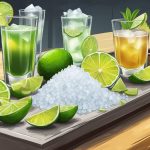As a whisky enthusiast, I have always been captivated by the rich and complex flavors that Japanese whiskies offer. Over the years, Japan has gained recognition as a formidable player in the world of whisky, with distilleries producing exceptional drams that rival those from Scotland and beyond.
1. Yamazaki 18 Year Old
One of the most revered Japanese whiskies, Yamazaki 18 Year Old is a true masterpiece. Its elegant and refined profile showcases notes of dried fruits, dark chocolate, and a hint of oak. The balance and depth of flavors in this whisky are truly exceptional.
2. Hakushu 12 Year Old
Hakushu 12 Year Old is a whisky that beautifully captures the essence of nature. Made at the foot of the Japanese Alps, this single malt offers a unique combination of fresh and fruity notes with a gentle waft of smoke. It takes you on a journey through lush forests and crisp mountain air.
3. Nikka Taketsuru Pure Malt
A tribute to the father of Japanese whisky, Masataka Taketsuru, this pure malt blend from Nikka is a harmonious marriage of whiskies from both the Yoichi and Miyagikyo distilleries. With its velvety texture and layered flavors of orchard fruits, nuts, and spices, it showcases the artistry and craftsmanship synonymous with Nikka.
4. Hibiki 21 Year Old
Hibiki 21 Year Old is a true symphony of flavors. This carefully crafted blend of malt and grain whiskies is aged to perfection, resulting in a whisky that dances on the palate. With its intricate flavor profile of citrus, honey, and Mizunara oak, each sip is a melodic experience.
5. Yoichi Single Malt
Produced at the famed Yoichi distillery, this single malt showcases the distinct character of peated Japanese whisky. The smoky and robust flavors, complemented by hints of brine and dried fruits, make Yoichi Single Malt a must-try for peat lovers.
6. Miyagikyo Single Malt
Miyagikyo Single Malt offers a gentler expression compared to its peaty counterpart. The whisky delights with its delicate aromas of orchard fruits, vanilla, and a touch of floral sweetness. It’s a true testament to the versatility of Japanese whisky.
7. Chichibu The Peated
A relatively young distillery, Chichibu has quickly gained recognition for its outstanding whiskies. The Peated expression is a standout, boasting rich smoky notes intertwined with layers of fruit, spice, and a touch of oak. This whisky truly exemplifies the exceptional craftsmanship of Ichiro Akuto, the founder of Chichibu.
8. Mars Shinshu Komasa Jyuku Whisky
Although relatively new to the scene, Mars Shinshu distillery has been creating waves with its exceptional offerings. Komasa Jyuku Whisky is a shining example of their craftsmanship, with its well-balanced flavors of malt, toffee, and a subtle spiciness. This whisky is a testament to the bright future of Japanese whisky.
9. White Oak Akashi Single Malt
White Oak Akashi Single Malt is a hidden gem in the world of Japanese whisky. This malt is matured in a unique combination of ex-bourbon and sherry casks, resulting in a whisky with a rich and luscious character. Its flavors of dried fruits, vanilla, and oak make it a delightful sip.
10. Ichiro’s Malt Chichibu On The Way
Another exceptional release from Ichiro Akuto’s Chichibu distillery, On The Way is a limited edition expression that showcases the promise of future releases. With its layers of fruit, spice, and a touch of smoke, this whisky leaves a lasting impression and builds excitement for what’s to come.
11. Kirin Fuji Sanroku Signature Blend
Kirin Fuji Sanroku Signature Blend is a whisky that embodies the beauty of Mount Fuji and the surrounding nature. With its well-rounded flavors of orchard fruits, honey, and a hint of spice, this blend is perfect for both newcomers to Japanese whisky and seasoned enthusiasts alike.
12. Suntory Toki
Last but certainly not least, Suntory Toki is a versatile and accessible whisky that offers a glimpse into the world of Japanese blends. With its light and crisp profile, it’s perfect for enjoying neat, on the rocks, or in your favorite cocktail.
In Conclusion
Japanese whiskies have carved a prominent place in the world of whisky, and the 12 expressions mentioned above exemplify the exceptional craftsmanship and dedication to quality that define Japanese distilleries. Whether you’re a seasoned whisky connoisseur or just beginning to explore the world of spirits, these whiskies offer an unforgettable experience.







